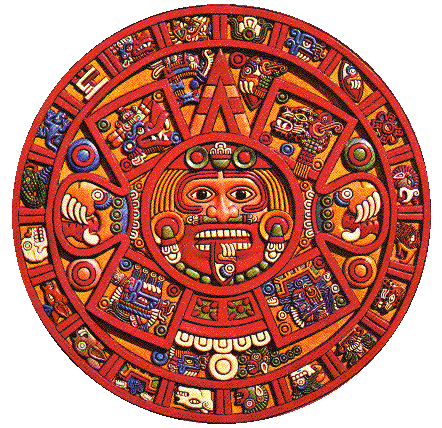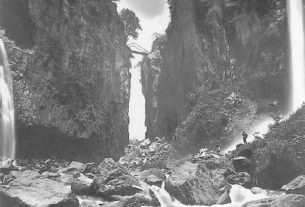The Aztec Calendar Stone is one of the most important monumental works of art left to us by the Aztecs. Since its discovery in what is now the main zocalo of Mexico City, it has been studied in minute detail. Much fairly accurate information about it is available to the public via the internet and in numerous articles and books. However, much misinformation tends to turn up in popular articles on the subject because of failure to consult primary source materials. One of the problems even for professional Mesoamerican scholars is the general lack of critical editions of Nahuatl texts, such as we have for the Greek and Latin classics. The situation is even more acute for popular writers who do not have access to original texts or primary sources. A case in point is the symbolism of the Aztec Calendar or Sun Stone, in particular the central pattern of the Glyph 4 Movement (Nahui Ollin), which frames the visage of Tonatiuh, the Sun God, and represents the Five Ages or Suns of Aztec cosmology.

The term Sun Stone is perhaps more appropriate than Calendar Stone because the only reference to the calendar is to the twenty day names of the Aztec month in the innermost of the concentric rings surrounding the face of Tonatiuh. The other symbols relate to the Aztec concept of the cosmos and, for this reason, we shall henceforth refer to the monolith as the Sun Stone.
One of the more thorough studies of Mesoamerican symbols of the gods, time, space, and animals was published in 1965 by the German-Mexican Society founded by Hermann Beyer, a well-known Mesoamerican scholar. Beyer himself wrote a detailed analysis of the symbolism of the Sun Stone. This is a good example of how research on ancient Mexico should be conducted in order to arrive at reasonably accurate results. We have too many examples of the opposite approach in the work of sensation-mongers, such as Von Daniken (Chariots of the Gods) and others. The real research is painstaking and sometimes tedious, but the end result justifies the pains taken.
Beyer took a comparative approach to the symbolism of the Aztec Sun Stone. Although the article was written in 1921, the research methodology remains valid today. First, Beyer pointed out that the Sun Stone, as important as it is for the study of Aztec thought and culture, is neither unique nor mysterious. It is one of a class of artifacts known technically as cuauhxicalli (“Eagle Bowl”). Other monumental artifacts similar to the Sun Stone exist, among them the almost equally famous Stone of Tizoc. In central Mexico, as P. D. Joralemon points out in his study of the symbol of the Olmec Dragon, the eagle was represented as carrying the hearts of sacrificial victims to the sun. The eagle therefore became a name for the sun itself, hence the designation of the Sun Stone as an “Eagle Bowl.” Joralemon further notes that the flames emanating from the two fire serpents surrounding the outer rim of the Sun Stone are “formally identical to Olmec flame eyebrows.” This is an example of how we arrive at the probable meaning of a symbol on the Sun Stone by establishing the prototype of a Mesoamerican symbol through the comparative approach.
Beginning with the face of Tonatiuh, the Sun, Beyer takes each feature of the Sun Stone in turn and compares it with similar items or artifacts found elsewhere. It is impossible in this article to review all the symbolic representations on the Sun Stone. Besides, most of this information is readily available to any interested person with a computer and an internet account. What is lacking in most cases is an explanation of how we arrive at the correct interpretation of each item. Here we shall simply look at a few examples to illustrate the methodology used in dealing with the signs and symbols of ancient Mexico.
One way to approach Mesoamerican religious concepts is through the careful examination of each system of religious symbolism, such as the Sun Stone, and then to compare it with other related or similar systems. In this way the accumulated knowledge leads to a more accurate interpretation of particular symbols. Indeed, even the face of the Sun God Tonatiuh in the centre has been interpreted as a symbol of earth rather than the sun. Beyer, however, points out several representations of the face of Tonatiuh as the sun in pictographic codices of central Mexico that show the same configuration as the Sun Stone, including the surrounding Glyph 4 Movement (Nahui Ollin). From this and other evidence, there is no doubt about the identification of the central face on the Sun Stone.
There are many other such examples. One more will have to suffice here, the hieroglyphic symbol for the all-important date 4 Movement. Once again, we have evidence from the pictographic codices of Central Mexico and adjacent areas. In the Codex Borbonicus, for example, the central circle occupied by the face of Tonatiuh in the Sun Stone is replaced by an eye surrounded by the Glyph 4 Movement as on the Sun Stone. We may note in passing that the central part (tsikuri) of the familiar so-called Eyes of God (“Ojos de Dios”) of the Huichol Indians also represents the deified face of the sun (Tau). The more traditional Huichol yarn paintings also show clearly the sun god throwing off fiery sparks which the marakame (shaman) must brave when he or she goes in search of the rock crystal or soul of a deceased shaman. Since the Huichols claim the Aztecs as their spiritual ancestors, it does not take a great stretch of the imagination to associate the Huichol concept with that of the Aztecs.
Many popular writers on ancient Mexico not only fail to indicate their sources but deal with the material in a most uncritical way. This has resulted in a failure to recognize the difference between the Five Ages depicted on the Aztec Sun Stone and the version found in the written sources. For example, one author refers to “…the destruction of the First Age, the Sun of Water, and then equates the destruction of the Aztec First Age with the Biblical account of the Flood …in which great floods of water covered the earth. Then in both accounts, new life begins” (I refrain from giving the names of authors or titles of their articles on diplomatic grounds). This order of the Ages, however, is out of sequence with order on the Sun Stone.
The problem is that the account of the Five Ages given by this author (let’s call this person Writer X) does not accord either with the sequence of the Ages on the Sun Stone or with the order in the 1558 written version of the Five Suns in the Leyenda de los Soles (“Legend of the Suns”), an appendix to the Anales de Cuauhtitlan, an anonymous manuscript in Nahuatl. The order of the Ages on the Sun Stone and in the appendix goes thus: A. (1) Sun 4 Tiger; (2) Sun 4 Wind; (3) Sun 4 Rain (of Fire); (4) Sun 4 Water; (5) Sun 4 Movement. The last (5) is the Fifth Sun, which, on the Sun Stone, comprises the surrounding four preceding ages plus the central figure of Tonatiuh. But the order in the first part of the Anales is different: B.(1) Sun 4 Water; (2) Sun 4 Tiger; (3) Sun 4 Rain (of Fire); (4) Sun 4 Wind; (5) Sun 4 Movement. Notice the discrepancy between the two lists. Only numbers (3) and (5) correspond, the rest are out of sequence. List B is the order followed by Leo-Portilla in his popular Spanish and English works: Los Antiguos Mexicanos (Mexico, 1961) and Pre-Columbian Literatures (Oklahoma, 1969), both of which are out of sequence with the order of the Ages on the Sun Stone.
Writer X obviously followed Leon-Portilla’s version. But since the version on the Sun Stone is definitely pre-Hispanic, I would suggest that it is more likely to represent the authentic Aztec order of the Ages. I do not know why Leon-Portilla chose the other version, but it is clearly out of sequence with the Sun Stone. That does not necessarily mean that it is “wrong,” but it leaves a lot to be explained. For example, by focusing only on the version at the beginning of the Anales, Writer X fails to take into account the interim period between the Fourth and Fifth Suns as described in the fuller version of the Leyenda de los Soles in the appendix to the Anales. According to this latter account, the universal flood that destroyed the human race occurred at the end of the Fourth Age, when humans were turned into fish. With a little stretch of the imagination, one can indeed, as Writer X did, see a parallel with the Biblical story of the flood. I am not an Aztec logician, but it would seem to make sense for the gods to turn people into fish to save them from the flood waters. However, in the 1558 version, we are told that Tezcatlipoca called forth noto (i.e. Nahuatl Nota, Amy Father”) and his consort nene (short for Nahuatl nenetl, lit. “Vulva,” but note the translation given by the pious Franciscan, Sahagun: “The nature of woman”) and told them to enter into a large hollowed log that had been prepared for them (an alternate Aztec version of Noah’s ark or Christian missionary influence?). There they remained until they heard the waters subside. Several major events then occurred during the aftermath of the flood, such as the generation of fire, the creation of the human race, and the discovery of maize, all of which took place before the birth of the Fifth Sun.
The symbols of the Ages on the Sun Stone are distinct enough and have been identified with certainty. The problem first arises in the two conflicting versions of the Ages, namely the one in the Anales itself and the other one in the appendix to the Anales. The first begins with Sun 4 Tiger, the second with Sun 4 Water. But if we begin with Sun 4 Water (see list B above), we miss out on the events between the Fourth and Fifth Suns. This seemingly trivial discrepancy between the two lists throws them out of sequence and makes nonsense of Writer X’s argument based on the assumption that the destruction by flood took place during the First Age, Sun 4 Water. It is also contrary to the order on the Sun Stone. Moreover, if we begin the count on the Sun Stone with Sun 4 Water and proceed counter-clockwise around the Sun Stone, the sequence there is also thrown out of kilter. Of course we cannot expect logical consistency in such an intermingling of history, legend, and myth as this, but the inconsistency in the different versions requires a more detailed analysis than we can attempt in this article.
The repetitive formulaic style of the 1558 appendix to the Anales supports the view that this written account of the Ages was passed on from pre-Hispanic oral tradition, backed up by pictographic codices, into the literary tradition through the medium of writing introduced by Spanish missionaries. From Spanish words in the text, such as diablo, it is also likely that it was taken down by a Spanish missionary or a literate Aztec convert from an oral performance only a few decades after the Conquest of Mexico in 1521.
To give some idea of the style of the original, we shall look at the opening lines of each of the five divisions in Nahuatl, followed by a translation and a few lines to indicate the context. The following is based on W. Lehmann’s Nahuatl-German critical edition of the Anales de Cuauhtitlan (1975, pp324 ff.) and Leon-Portilla’s Filosofia Nahuatl (1966, 332 ff.). This is the order on the Sun Stone and in the appendix to the Anales.
I. SUN 4 TIGER: inin tonatiuh nahui ocelotl ocatca – 676 years (“The Sun 4 Tiger lasted 676 years. Those who lived in the first Sun were eaten by tigers at the time of the Sun 4 Tiger…”).
II. SUN 4 WIND: inin tonatiuh nahui ecatl ytoca (“This Sun is called 4 Wind. Those who lived in second place in this second Sun were taken up by the wind at the time of the Sun 4Wind…”).
III. SUN 4 RAIN [OF FIRE]: inin tonatiuh nahui quiyahuitl (“This Sun is called 4 Rain. The people who lived in the third age at the time of the Sun 4 Wind, they perished as well. Fire rained upon them and they turned into peacocks…”).
IV. SUN 4 WATER: inin tonatiuh nahui atl itoca (“This Sun is called 4 Water, the time during which the water lasted for 52 years… The year was 1 House, the day sign Four Water, and so they perished. Every mountain was destroyed. The water lasted 52 years and with that their years came to an end..”).
The Anales goes on to tell us of events during the Fourth Sun before its final destruction by a universal flood. There appears, therefore, to be an interim period before the birth of the Fifth Sun, our present Sun, during which the gods apparently re-create the human race and provide sustenance in the form of maize.
V. SUN 4 MOVEMENT: inin tonatiuh itoca naollin [Nahui Ollin] (“This Sun is called 4 Movement. This is our Sun in which we now live…”).
With the birth of the Fifth Sun, we enter our own age. This is the time when the present Sun was created at Teotihuacán through the self-sacrifice of the sickly god Nanahuatzin, who threw himself into the fire and emerged as the Sun. Many years ago, I sat in the Great Square of Teotihuacán and listened to Professor Margain of the Anthropology Department at the U.N.A.M in Mexico City describe to us students the sacrifice of Nanahuatzin on the altar just in front of us. But back to the Anales….
The Sun did not move at first in the Anales account because the Sun God required human sacrifice in return for the initial sacrifice of the gods on behalf of the human race. It is a little unclear in this context what finally got the Sun moving properly, but the Huichol Indians know what happened. Some time ago my friend Joaquin Carillo, a Huichol from San Andres, gave me a Huichol creation story taken down from the narration of a relative. It was in Huichol with a rough translation in Spanish. Between the two, I produced an English version. We cannot go into details here but I found many echoes of the classical Aztec version in the Huichol account, such as the conspicuous recurrence of the numeral five and the problem of the recalcitrant Sun, which at first refused to move. For example, in the Huichol version the deity Nakawé raised up the Sun five times with his staff, until it remained where it is today.
Obviously the text of the Anales requires a much more detailed analysis than can be attempted here. Our task, however, is to try to think like an Aztec, not twist the thoughts or words of others to fit our own preconceptions.


